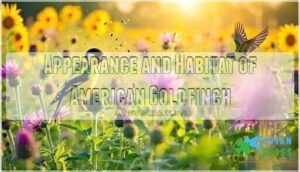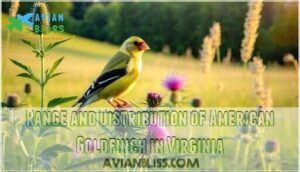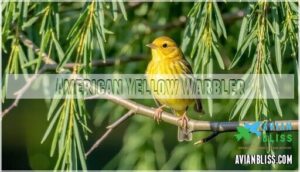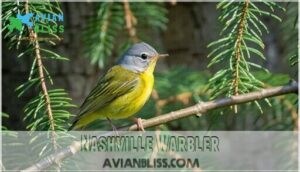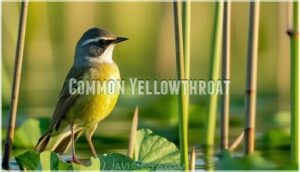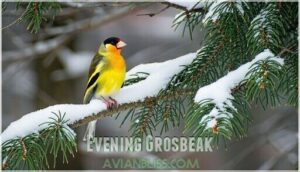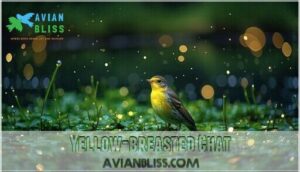This site is supported by our readers. We may earn a commission, at no cost to you, if you purchase through links.
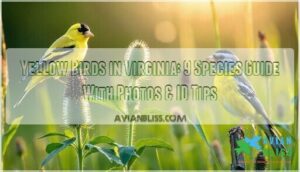 You’ll spot nine distinct yellow birds in Virginia’s diverse landscapes, from your backyard feeders to dense forest thickets.
You’ll spot nine distinct yellow birds in Virginia’s diverse landscapes, from your backyard feeders to dense forest thickets.
The bright American Goldfinch steals the show with its canary-yellow plumage and acrobatic feeding style, while secretive species like the Yellow-breasted Chat prefer staying hidden in brambles.
Warblers dominate this colorful crew—Wilson’s, Nashville, and Yellow-rumped varieties migrate through or nest here seasonally.
The Common Yellowthroat skulks in wetlands with its distinctive black mask, and if you’re lucky, Evening Grosbeaks might visit during winter irruptions.
Each species has unique field marks, preferred habitats, and behaviors that’ll help you distinguish one golden beauty from another.
Table Of Contents
- Key Takeaways
- American Goldfinch
- Wilson’s Warbler
- American Yellow Warbler
- Myrtle Warbler (Yellow-rumped Warbler)
- Nashville Warbler
- Common Yellowthroat
- Evening Grosbeak
- Yellow-breasted Chat
- Magnolia Warbler
- Frequently Asked Questions (FAQs)
- What is the difference between yellow and goldfinch?
- Are yellow warblers in Virginia?
- What is a small yellow bird with black wings in Virginia?
- When do yellow birds migrate through Virginia?
- What attracts yellow birds to backyard feeders?
- How to identify female versus male yellow birds?
- Which yellow birds stay year-round in Virginia?
- What plants attract yellow birds for nesting?
- Conclusion
Key Takeaways
- You’ll find nine distinct yellow bird species in Virginia, with the American Goldfinch being your most reliable year-round resident that’s easily spotted at backyard feeders with its bright yellow plumage and black wings.
- Most yellow birds you’ll see are seasonal visitors – warblers like Wilson’s, Nashville, and Yellow-rumped varieties migrate through Virginia during spring and fall, while Yellow Warblers nest here from April to August.
- You can attract these birds by planting native species like willows, elderberry, and sunflowers, plus offering nyjer and sunflower seeds at feeders – especially effective for goldfinches who eat only seeds.
- Each species has unique identifying features that’ll help you tell them apart: look for the Common Yellowthroat’s black mask in wetlands, the Evening Grosbeak’s massive bill during winter irruptions, and the Yellow-breasted Chat’s white eye rings in dense thickets.
American Goldfinch
You’ll recognize the American Goldfinch as Virginia’s most common yellow bird, with males showing brilliant yellow plumage and black wings during breeding season.
This year-round resident frequents backyards, gardens, and open fields throughout the state, making it easy to spot at seed feeders or perched on thistle plants, which are a key part of its habitat and can be considered year-round attractions.
Appearance and Habitat of American Goldfinch
Across Virginia’s backyard habitats, you’ll spot male American goldfinches flashing their brilliant yellow plumage with contrasting black wings and cap during breeding season.
Virginia’s golden ambassador flashes through backyards, turning ordinary feeders into wildlife theaters with brilliant yellow breeding plumage.
These acrobatic yellow birds, Virginia residents, transform dramatically through winter adaptations, molting to olive-brown tones while retaining distinctive black wings. Females maintain subtler yellow-olive coloring year-round.
Their conical bills perfectly suit their seed preferences, targeting thistle, sunflower, and aster seeds. Virginia birds identification becomes easier noting their undulating flight pattern and cheerful calls.
Regional abundance peaks in open fields, meadows, and gardens where yellow finches Virginia populations thrive on abundant seed sources from native plants and feeders. Consider goldfinch seed options to attract them, focusing on native plants and seed sources to support these beautiful birds.
Range and Distribution of American Goldfinch in Virginia
American Goldfinch maintains a year-round presence throughout Virginia, making it one of the state’s most reliable yellow birds virginia residents.
You’ll find local abundance peaks in counties like Arlington, where 853 individuals were recently counted.
Their seasonal movements involve shifting from open fields to backyard feeders during winter months.
Habitat variation influences their distribution—they prefer meadows and agricultural areas over dense forests.
Regional differences show higher reporting frequencies in May (19.0%) compared to February (4.66%).
These backyard sightings make them perfect for virginia birds identification practice using any bird identification guide or bird range maps.
Sightings can be tracked using eBird’s interactive maps.
Wilson’s Warbler
When scouting for yellow warblers in Virginia, Wilson’s Warbler stands out with its distinctive black cap and bright yellow underparts.
This tiny songbird measures just 4 inches long, making Wilson’s ID challenging but rewarding for bird watching Virginia enthusiasts.
Here are three key identification features:
- Males sport a bold black cap contrasting with lemon-yellow face and breast
- Females show variable black markings on their olive-yellow heads
- Both sexes display thin bills perfect for catching insects
Wilson’s Warbler habitat preferences include dense shrubby thickets near streams, especially in Virginia’s higher elevations.
Their diet specifics focus on beetles, flies, and larvae – comprising 30% of their meals.
Unfortunately, their conservation status shows declining populations due to habitat loss.
These energetic birds arrive in April, filling woodlands with buzzy songs before departing by August for their western range wintering grounds.
They then migrate to locations in the northern Caribbean islands.
American Yellow Warbler
When you spot a bright yellow bird with rusty-red breast streaks darting through Virginia’s streamside willows, you’ve likely found an American Yellow Warbler.
Virginia’s golden jewel flashes through willows—the Yellow Warbler’s sweet song announces spring’s arrival.
These cheerful songbirds arrive in late April after their incredible journey from Central America, bringing their sweet, descending "sweet-sweet-sweet-I’m-so-sweet" song to riparian areas statewide.
Habitat Preference centers on moist woodlands, particularly willow thickets and wetland edges where insect abundance peaks.
Dietary Habits focus heavily on caterpillars—they’re like feathered pest controllers, consuming 67% insect larvae plus spiders and beetles.
Breeding Behavior involves monogamous pairs building cup-shaped nests in shrubs, with females laying 4-5 eggs.
Migration Patterns show early departure by late August for tropical wintering grounds.
Conservation Status remains stable overall, though habitat loss affects local populations.
Protecting Virginia’s riparian corridors guarantees these delightful yellow bird species continue gracing our summers.
Myrtle Warbler (Yellow-rumped Warbler)
You’ll spot the Yellow-rumped Warbler by its distinctive yellow patches on the rump and sides, earning it the nickname "Myrtle Warbler."
This adaptable songbird visits Virginia as a summer resident from May through August, then winters in warmer regions while some individuals pass through during migration.
Description and Adaptations of Myrtle Warbler
You’ll recognize the Myrtle Warbler by its distinctive rump coloration – that bright yellow patch that flashes as it moves through Virginia’s woodlands.
This warbler species showcases remarkable plumage variation between seasons and subspecies differences across regions.
- Winter adaptations include a waxy coating digestion ability unique among warblers
- Gray-brown winter plumage transforms into striking breeding colors with yellow sides
- Foraging behavior involves quick flights between branches, catching insects mid-air
These yellow birds in Virginia demonstrate incredible versatility in bird identification challenges.
Their yellow rump remains consistent year-round, making them easier to spot than other warbler species in Virginia’s diverse habitats.
Myrtle Warbler’s Preferred Habitats and Diet
You’ll spot Myrtle Warblers in diverse Virginia bird habitats, from coniferous forests during breeding to shrublands in winter.
Their remarkable Habitat Variation supports year-round Regional Abundance.
Winter Diet shifts from Insect Consumption (caterpillars, beetles) to waxy berries like bayberry—a unique adaptation among warblers.
Understanding their dietary needs is essential for successful birdwatching.
Their versatile Foraging Behavior includes hawking insects and gleaning from branches, making bird identification easier through consistent feeding patterns.
Nashville Warbler
While Yellow-rumped Warblers prefer coniferous forests, you’ll find Nashville Warblers thriving in entirely different Virginia wildlife habitats.
These compact songbirds measure just 4.3-5.1 inches with distinctive gray heads, white eye-rings, and bright yellow throats that’ll catch your eye immediately.
Nashville ID becomes easier when you notice their olive-green backs and lack of wing bars—key features separating them from similar Yellow birds species.
Their habitat preferences include shrubby second-growth areas, regenerating clearcuts, and mixed hardwood-pine forests with dense undergrowth.
Migration patterns bring Nashville Warblers through Virginia during April-May and September-October as they travel between Canadian breeding grounds and Central American wintering areas.
Their diet consists entirely of insects—flies, caterpillars, beetles, and grasshoppers gleaned from leaf undersides while flicking their tails.
Conservation status remains stable with 40 million birds globally, though habitat loss threatens some populations.
You’ll spot these Yellow Warbler relatives foraging deliberately in lower vegetation layers throughout Virginia’s forests.
Common Yellowthroat
Mystery surrounds this warbler’s black-masked face as it darts through Virginia’s wetlands. The Common Yellowthroat’s Masked Appearance makes males unmistakable—bright yellow throat and breast contrasting with their distinctive black "bandit mask" edged in white.
Females sport olive-brown backs with subtler yellow coloring and lack the dramatic facial marking. You’ll find these yellow birds in Virginia’s marshes, dense shrublands, and overgrown fields where their Habitat Preferences favor thick, low vegetation near water.
Their Vocalizations include the famous "witchity-witchity-witchity" song that echoes from cattail stands and brushy areas. During Breeding Behavior, females build concealed cup nests just inches above ground using grasses and bark strips.
Both parents feed nestlings soft insects they glean from leaves and stems. Virginia wildlife enthusiasts practicing birdwatching should note their Conservation Status faces pressure from wetland loss, making habitat protection vital for maintaining healthy populations of these energetic masked warblers throughout the state.
Evening Grosbeak
These massive finches arrive in Virginia during unpredictable winter irruptions, chasing food sources across the continent.
Evening Grosbeak identification becomes straightforward once you notice their exceptionally thick, conical bills—perfect for cracking tough seeds.
Males display brilliant yellow-orange plumage with striking black wings featuring white patches, while females show gray bodies with olive-yellow tinges.
Their Grosbeak habitat preferences include coniferous forests for breeding, but they’ll venture into deciduous woodlands and suburban areas with feeders during winter.
Grosbeak diet consists primarily of tree buds, maple seeds, and spruce cones, though they’ll readily visit backyard feeders stocked with sunflower seeds.
Grosbeak migration patterns follow boom-and-bust cycles tied to northern food availability.
To stay informed, utilize a rare bird alert system for updates.
Unfortunately, Grosbeak conservation concerns are mounting—populations have plummeted 92% since 1970, making them one of North America’s most rapidly declining bird species.
When birdwatching in Virginia, listen for their distinctive whistle calls echoing through winter woods.
Yellow-breasted Chat
Looking at Virginia’s dense thickets, you’ll find one of North America’s most distinctive songbirds. The Yellow-breasted Chat stands out with its bright yellow throat and breast, olive-green back, and striking white eye rings. Males display black lores between their bill and eye, while females show gray markings in this area.
This seven-inch songbird prefers shrubby habitats throughout Virginia’s coastal regions, particularly streamside thickets and overgrown fields. You’ll hear their elaborate nocturnal song flights featuring chaotic mixes of hoots, whistles, and mimicked calls.
Chat Identification features include:
- Large, stout black bill and sturdy body structure
- White whisker stripes contrasting with yellow underparts
- Longer tail than typical wood-warblers
Chat Diet consists primarily of insects like bees and grasshoppers, plus berries including blackberries and wild grapes. Chat Behavior includes skulking through dense vegetation while performing conspicuous breeding displays.
Chat Conservation efforts focus on maintaining early successional habitats as Yellow-breasted Chat populations face regional declines from development pressures across Virginia birds communities. The chat’s olive-gray feathers are complemented by a distinct white eyebrow.
Magnolia Warbler
This striking warbler species earns its reputation as one of Virginia’s most distinctive yellow birds in Virginia during migration seasons. You’ll spot Magnolia Warblers by their bold black necklace across bright yellow underparts and unique white tail patches—key features for identifying birds among similar warbler species.
These Virginia birds follow specific Migration Patterns, passing through from late April to late May and again from late August to mid-October. During their brief Virginia visits, Magnolia Warblers showcase fascinating Breeding Habits developed in northern coniferous forests.
Males perform elaborate courtship displays with fluttering wings while delivering high-pitched songs. Their Habitat Specificity becomes evident as they forage actively on outer branches, plucking caterpillars and spiders from foliage.
Identification Challenges arise when distinguishing them from other yellow warblers, but their distinctive tail pattern makes recognition easier. While their Conservation Status remains stable, these remarkable migrants remind us that nature’s beauty often comes in small, fleeting packages.
Frequently Asked Questions (FAQs)
What is the difference between yellow and goldfinch?
Yellow Warbler refers to a specific bird species that’s uniformly bright yellow, while American Goldfinch is another distinct species.
You’ll spot goldfinches by their black wings and seasonal color changes—males turn vivid yellow with black caps in summer, then brownish in winter, which is a key characteristic to distinguish them from the Yellow Warbler, and this change showcases their seasonal adaptation.
Are yellow warblers in Virginia?
Yes, you’ll find Yellow Warblers throughout Virginia during breeding season from April to August.
They’re bright yellow neotropical migrants that prefer moist habitats like streamside willows, woodland edges, and gardens before heading south for winter.
What is a small yellow bird with black wings in Virginia?
That feathered friend you’ve spotted is likely an American Goldfinch.
You’ll recognize these charming seed-lovers by their bright yellow bodies and distinctive black wings with white markings—they’re year-round Virginia residents.
When do yellow birds migrate through Virginia?
Peak migration happens during spring (late April through June) and fall, when you’ll spot the most yellow songbirds moving through Virginia’s landscapes and migration hotspots.
What attracts yellow birds to backyard feeders?
Diet drives attraction – American Goldfinches eat only seeds, so you’ll draw them with nyjer, sunflower, and thistle seeds in tube feeders year-round in Virginia backyards.
How to identify female versus male yellow birds?
Males typically show brighter yellows with distinct markings like black caps or streaks, while females display duller, olive-toned plumage for camouflage during nesting season.
Which yellow birds stay year-round in Virginia?
You’ll find American Goldfinch as Virginia’s main year-round yellow resident.
They’re present throughout all seasons, though they’ll shift locations locally based on food availability and appear more brownish during winter months.
What plants attract yellow birds for nesting?
You’ll want native plants that provide nesting materials and attract insects.
Willows, elderberry, and dogwood offer flexible twigs for nest construction.
Sunflowers, asters, and thistle provide both seeds and nesting fibers that goldfinches love.
Conclusion
Virginia’s yellow birds migrate at staggering rates—some Nashville Warblers travel over 2,000 miles from Central America just to nest here.
Now you’ve got the tools to identify these golden treasures flitting through your neighborhood.
Whether you’re tracking American Goldfinches at feeders or listening for Yellow-breasted Chats in dense thickets, each species offers unique rewards for patient observers.
Keep your binoculars ready and field guides handy—these yellow birds in Virginia will transform ordinary walks into exciting birding adventures.

